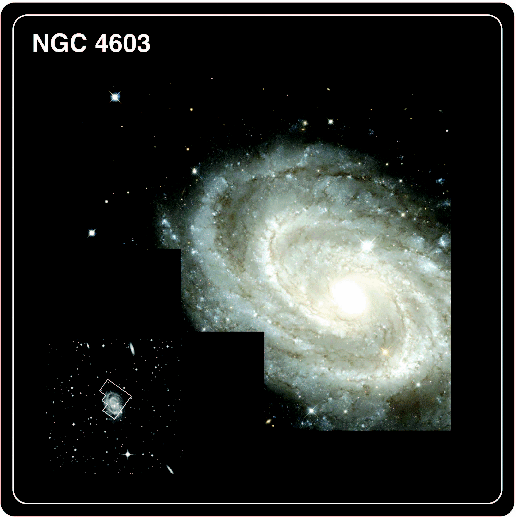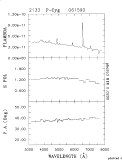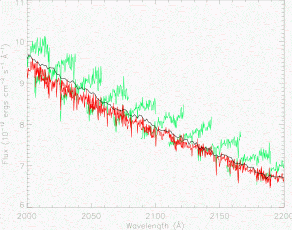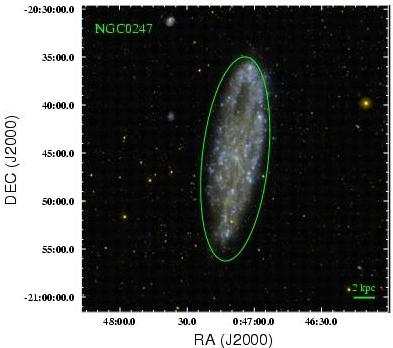|
|||||||||||||||||||
|
|
|||||||||||||||||||
The Multimission Archive at STScI Newsletter
| January 5, 2007 | Space Telescope Science Institute | Volume 18 |
| The Multimission Archive at STScI (MAST) Newsletter disseminates information to users of the HST, FUSE, GALEX, IUE, Copernicus, EUVE, HUT, UIT, WUPPE, HPOL, IMAPS, BEFS, TUES, VLA-FIRST, and XMM-OM data archives supported by MAST. Inquiries should be sent to archive@stsci.edu. |
Table of Contents

|
New GALEX Data Delivery: "GR3" January 2007
|
In December the GALEX Project delivered direct images in a new
public release, GALEX Release 3 (GR3).
On January 5, 2007, the GR3 data for the MIS, NGS, DIS, CAI and GII surveys were released.
The AIS and Grism data will be available in the next weeks.
Check the "News" notice at the top of the GALEX
homepage at http://galex.stsci.edu for news updates.
The GR3 data have been processed with the identical pipeline processing system as GR2 and is approximately the same size as GR2. The only differences with respect to the GR2 is GR3's coverage of new sky tiles and its inclusion for the first time of datasets from former GI programs and calibration data. The acronyms for these programs are GII and CAI. THE GII dataset is separate from the "Guest Investigators Program" dataset. Like the new CAI and other survey datasets, it can be queried at the level of individual objects. By late December all imaging data have been received at MAST from the project. The data volume is about 1.6 TB. To the right is a table summarizing the GR3 delivery. Note that a "tile" is a generally circular region on the sky of radius slightly larger than 0.6 degrees. Grism spectra will be delivered from the project sometime in January and will be made available soon after delivery. Shortly after this release MAST hopes to provide a beta version of a "Google-style" map for GALEX data, which will permit data discovery for all public data by this map service. This tool will greatly facilitate visualization and answer questions at a glance about whether sky regions of interest are covered yet by any of the various GALEX surveys. |
|
Searching by object classes
You may have wanted to search the MAST mission database for certain classes of objects, but found that the object class information provided by the PIs incorrect, incomplete and generally not useful.
MAST provides interfaces that allow you to utilize catalogs from VizieR or the intrinsic NED classifications as a basis for a cross-correlation search with MAST databases. Inga Kamp has prepared a brief tutorial showing how to utilize these search tools. You may download it as a PowerPoint presentation or view it as a web page.
Final Recalibration of STIS data
As this article is being written, the final recalibration of all existing STIS data (i.e., data taken before 4 August 2004) is in progress. The work is being done by DPAS branch personnel during times when the regular processing, ingest, and data delivery load is low, to minimize interference with normal operations.
As part of the processing, the data are being reingested into the HST Data Archive and placed in a cache on the MAST disks. After the reprocessing is complete, OTFR for STIS will be turned off. After the reprocessing effort is complete, the final calibrated data will be available through DADS and the "hstonline" interface, which provides immediate download of the data. The data will also be available via anonymous ftp (logon onto archive.stsci.edu, then cd to /pub/hstonline/). See the article on GHRS and FOC final calibration for details of the directory structure.
Before the recalibration effort began, the STIS team substantially improved the calibration software, added many enhancements and updated the calibration reference files. A partial list of the improvements and enhancements is given below. Details are available in various STIS STANs (http://www.stsci.edu/hst/stis/documents/newsletters) and in the Fall 2006 STScI Newsletter (http://sco.stsci.edu/newsletter/).
GHRS and FOC final data processing
The decision to reprocess the data for the GHRS and FOC instruments was made for three reasons. First, it was obvious that no changes were occurring to the calibration files and calibration software for these instruments. Second, because of the lack of maintenance for the calibration software -- the original instrument team members are gone or busy supporting other instruments--, we were facing the danger of losing the capability to recalibrate the data in the near future. And third, the data in the archive was calibrated shortly after it was taken with sometimes not optimum reference files. On The Fly Reprocessing (OTFR) was never available for GHRS and FOC and so the files in the Archive were static and did not get reprocessed as better reference files came along later in the mission. CADC, ST-ECF and MAST decided on a collaborative effort to process the entire GHRS and FOC holding with a consistent set of reference files representing now the best calibration. After thorough testing of the calibration software and databases, we used the OTFC pipelines at the ST-ECF to produce the final calibrated files for both instruments. The reprocessing effort is documented in two Instrument Science Reports (FOC-99 and GHRS-92).
We are currently providing an alternate interface under the name "hstonline" to these data, because it has not yet been reingested into DADS. We also include the final calibrated data for the FOS instrument in this online archive. Even though this FOS data can be retrieved via DADS, the online interface provides direct access to the data on disk. After the STIS reprocessing effort has been completed, STIS data will also be included in this interface for the same reasons. We kept the search interface for the Legacy Instruments very similar to the general HST search interface. The difference is that when you mark data to be retrieved, they will be downloaded directly to your computer in a tar file. This download does not utilize the DADS batch retrieval method and should therefore be faster. The download procedure is similar to that for IUE and other MAST missions whose data is not archived in DADS.
The data are also available via anonymous ftp. FTP to archive.stsci.edu logging in as anonymous. CD to /pub/hstonline. The data are stored in a set of subdirectories following the format /pub/hstonline/XXXX/datasetname where XXXX is the first four letters of the dataset name, effectively grouping the data by proposal. For dataset X0ND0101T the path would be /pub/hstonline/x0nd/xond0101t.
New Community Contributed Science Ready Products
High-Level Science Products (HLSP) are fully processed (reduced, co-added, cosmic-ray cleaned etc.) community provided images and spectra that are ready for scientific analysis. HLSPs also include object catalogs and spectral atlases. MAST archives HLSPs which have data from MAST missions as an integral part of the products. The data are accessible through the MAST web page and are also available via ftp download. We have made most HLSP images available through the Virtual Observatory (VO) and its common tools such as Aladin. See a complete list of currently held HLSP at http://archive.stsci.edu/hlsp/index.html.
Four sets of HLSP have been archived since the last archive newsletter.
Catalogs of B-, V- and i-band dropout sources for the GOODS North and South fields and the HUDF (PI: Beckwith)
S. Beckwith et al. (2006) have prepared catalogs of dropout sources for both the GOODS North and South fields and the Hubble Ultra Deep Fields based on the original projects source catalogs. The readme and the associated catalogs are at http://archive.stsci.edu/pub/hlsp/dropouts/. The paper can be found on astro-ph/0607632.
GALEX Atlas of Nearby Galaxies (PI: Gil de Paz)
MAST is pleased to present this atlas of UV images obtained by NASA's Galaxy Evolution Explorer (GALEX) satellite.
This atlas was prepared by A. Gil de Paz, S. Boissier, B.F. Madore, M. Seibert and associated members
of the GALEX Team. The full paper is posted on
astroph/0606440 and will be published in the ApJS in 2007.
The team presents images, integrated photometry, surface brightness, and color profiles for a total of 1034
nearby galaxies observed by GALEX in its far-ultraviolet (FUV: 1516 Å and near-ultraviolet (NUV: 2267 Å) bands. Some images are still proprietary and will be released upon publication in the ApJS.
For more information about these data see the website http://archive.stsci.edu/prepds/galex_atlas.
 WFPC2 Spiral Galaxies (PI: Holwerda)
WFPC2 Spiral Galaxies (PI: Holwerda)
Holwerda et al. examined 32 HST/WFPC2 archival fields of 29 spiral galaxies (Sab and later) for their paper The Opacity of Spiral Galaxy Disks. IV. Radial Extinction Profiles from Counts of Distant Galaxies Seen through Foreground Disks (2005, AJ,129:1396-1411). The majority of the data are from the Cepheid distance scale Key Project. The explicit goal was to provide deep mosaics in both V- and I-band with a better sampling in order to identify background galaxies through the foreground disk.
 ACS mosaic images of M82 (PI: Mountain)
ACS mosaic images of M82 (PI: Mountain)
In March 2006, the Hubble Heritage Team obtained a large 4-color mosaic image of the M82 with the Advanced Camera for Surveys (ACS) onboard the Hubble Space Telescope (HST).
The M82 data were obtained in four filters: B, V, I, and H-alpha.
See 10776 (PI: Matt Mountain) for details.
The resulting color composite image was released to the community on April 24, 2006 to celebrate Hubble's 16th anniversary. Since the M82 mosaics produced by the Hubble Heritage Team represent a significant investment of expert processing beyond the standard archival products, these drizzle-combined FITS files have now been released as a High-Level Science Product via the Multimission Archive at Space Telescope (MAST). A very complete text-only README file has been provided which describes key aspects of the observing program, the standard pipeline processing, and the post-pipeline combination of these images into complete mosaics. A paper (to be published Jan 2007 in PASP) describes the processing in detail. The paper has been posted to astro_ph
http://arxiv.org/abs/astro-ph/0612547.
We are interested in archiving your High-Level Science Products!
HLSPs are provided by experienced users and legacy teams, who make their calibrated data available to the community after a careful and sophisticated process. Our archive retrieval statistics over the past year reveal that the HLSPs get downloaded !10 time more often than the average HST pipeline processed dataset. This will certainly reflect in the citation index of associated papers.
If, as part of your research, you have produced such science ready data products based on data from any of the missions archived at MAST and you are interested in contributing them as HLSP to MAST, please see our page of guidelines and contact us at archive@stsci.edu.
Wisconsin Halfwave Spectropolarimeter data (HPOL)
 The first set of Wisconsin Halfwave spectropolarimeter (HPOL) data has been archived at MAST.
The data was obtained at the Wisconsin Pine Bluff Observatory and archived as a complement to the existing
WUPPE spectropolarimetric data.
The HPOL spectropolarimeter is a modified Boller and Chivens small telescope spectrograph.
The system provides simultaneous spectrophotometry and spectropolarimetry over the range of
3200Å to 10500Å (prior to 1995, the spectral range was 3200Å to 7750Å)
with a spectral resolution of 10Å (25Å prior to 1995).
HPOL data includes roughly 1500 low dispersion observations of 310 targets
acquired between 1989 and 1994. HPOL CCD data (1995-2004), some of which was obtained at Kitt Peak,
will be delivered and archived in the future.
The first set of Wisconsin Halfwave spectropolarimeter (HPOL) data has been archived at MAST.
The data was obtained at the Wisconsin Pine Bluff Observatory and archived as a complement to the existing
WUPPE spectropolarimetric data.
The HPOL spectropolarimeter is a modified Boller and Chivens small telescope spectrograph.
The system provides simultaneous spectrophotometry and spectropolarimetry over the range of
3200Å to 10500Å (prior to 1995, the spectral range was 3200Å to 7750Å)
with a spectral resolution of 10Å (25Å prior to 1995).
HPOL data includes roughly 1500 low dispersion observations of 310 targets
acquired between 1989 and 1994. HPOL CCD data (1995-2004), some of which was obtained at Kitt Peak,
will be delivered and archived in the future.
Specview Improvements
Over the last several months, Specview has been improved to permit
uploading of any spectroscopic datasets adhering to the Simple Spectral
Access Protocol in the VO web registry. A function has also been added
to both the "application" version (that is, one residing in the client
computer) and the trusted-applet versions of Specview to fit "continuum
windows" of a spectrum with a polynomial. Specview v2.13 was released
which includes a library of standard spectra and fitting models taken
from the Kurucz grid of atmospheric models. Coming soon, the continuum
fitting function will be implemented with an orthogonal polynomial function.
Archive Status
 The MAST Archive continues to expand its holdings and services. At the end of December 2006,
over 46 TB of data was archived in the HST and MAST Archives. In the past 6 months, about 2 TB of data
was archived while over 14 TB of data was distributed.
The MAST Archive continues to expand its holdings and services. At the end of December 2006,
over 46 TB of data was archived in the HST and MAST Archives. In the past 6 months, about 2 TB of data
was archived while over 14 TB of data was distributed.
DADS retrieval times continue to be good. The median time to complete a request remains around an hour.
How Can MAST Improve and Expand to Serve You Better?
 MAST is continually looking for ways to help you find the data you want
and we would really like to hear your ideas.
We have provided a "suggestion box" at
http://archive.stsci.edu/suggestions.html and encourage you to post suggestions, comments and concerns through this interface. A link to the suggestion box is found on the second line of the top menu on most MAST web pages.
MAST is continually looking for ways to help you find the data you want
and we would really like to hear your ideas.
We have provided a "suggestion box" at
http://archive.stsci.edu/suggestions.html and encourage you to post suggestions, comments and concerns through this interface. A link to the suggestion box is found on the second line of the top menu on most MAST web pages.
Some past users have allowed us to post their suggestions. Those suggestions and the MAST responses can be found at
http://archive.stsci.edu/suggestion_response.html.
Let us hear from you!
To Subscribe or Unsubscribe to the Newsletter
If you would like remove yourself from the mailing list send mail to archive_news-request@stsci.edu and put the single word unsubscribe in the BODY of the message. Information on the subject line will be ignored.If you would like to subscribe to the mailing list to receive notification of future Archive Newsletters, send mail to archive_news-request@stsci.edu and put the single word subscribe in the BODY of the message. Information on the subject line will be ignored. You will be asked to confirm the subscription.




 Follow Us
Follow Us
